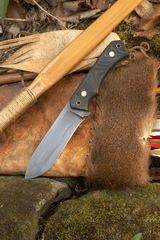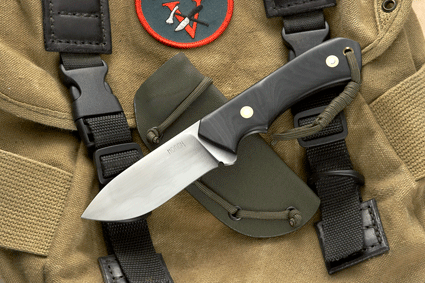If you say “style,” a sea of images comes to mind—Porsches, Rolexes or Stetson fedoras. Rarely do I think of style in the knife world, especially in tactical or outdoor knives. Most buy knives for their effectiveness and durability, not because they look good. Recently, I was enthused to see that one could bring both style and flavor to the knife scene. Enter Tim Horan. Tim is a knife maker located near Chicago, Illinois. He is a die hard knife collector and blade connoisseur who began grinding knives over six years ago, taking inspiration from David Beck, Walley Hayes and Robert N. Rossdeutscher. His style and taste in blade grinding and materials go against the grain of many modern bladesmiths. For example, he uses a less common clay heat-treating process. The procedure utilizes clay that is sandwiched on the edge, for a varied softness in the heat treat along the blade matrix.
 Horan’s knives seep with ruggedness and practicality of design. Designing knife blades was more of a hobby for Tim until recent years, when some of the knives he created were starting to of his craftsmanship and quality grew, so did his orders. Tim, a former firefighter, is no rookie to using knives in high-pressure situations. He once discussed a time when he had to cut a car accident victim out of a leather jacket and seatbelt harness. There aren’t many knife makers that have had a chance to test bladeware themselves in that real-world fashion. Using his experiences as a professional, he went about designing knives and crafting them for real-world use. Eventually, he was forced to relinquish his duties as a fireman to focus more of his efforts on meeting the demand for his knives.
Horan’s knives seep with ruggedness and practicality of design. Designing knife blades was more of a hobby for Tim until recent years, when some of the knives he created were starting to of his craftsmanship and quality grew, so did his orders. Tim, a former firefighter, is no rookie to using knives in high-pressure situations. He once discussed a time when he had to cut a car accident victim out of a leather jacket and seatbelt harness. There aren’t many knife makers that have had a chance to test bladeware themselves in that real-world fashion. Using his experiences as a professional, he went about designing knives and crafting them for real-world use. Eventually, he was forced to relinquish his duties as a fireman to focus more of his efforts on meeting the demand for his knives.
Advertisement — Continue Reading Below
Tim was once an avid woodworker, but just creating things such as jewelry boxes out of wood took a fatal turn once he ground his first edge. “You finish this thing (jewelry box) and look at it and it’s a box; it’s not like the feeling I get after making a knife. You can use it; you can create a story for it with each use,” Tim said. True for any knife maker. Jewelry boxes are warm and sentimental, but you can’t field dress a deer with one. Tim uses only his hands when working his knives; he utilizes hand files even for the saw blades on the back of his wilderness survival knife.
Q-Tanto Strikes Back
Perhaps the truest certification to Tim’s versatility is his Q-Tanto. Truly a functional work of art, the Q-Tanto has a traditional Japanese Ito cord wrap made out of silk from Japan and genuine tough ray skin, giving it zest underneath. Just to make sure that the handle stands up to the elements, the silk cord wrap is treated with a marine grade resin. The cord wrap is not going anywhere! It is important for a cord wrap to stay put; having one come apart can be quite a task to re-wrap without a vise, as most have not brushed up on their Japanese cord wrap lately.
The Q-Tanto along with all other Horan knives, utilize differential heat treatment. This type of heat treatment presents the user with a very hard edge but a soft spine. This takes shock absorption really well, making them true beaters. The knife maker takes about 1/8-inch of clay and forms it on the blade. He can break up the pattern so there are different hamon lines on it. Most of his tantos are made out of W-2, an exceptionally durable steel that Tim reports reacts well to differential heat treatment. This process yields a hamon line near the knife edge. The result is a breathtaking, almost flare-like sun pattern on the blade. Each knife has its own hamon, as unique as a human fingerprint. There were two other Horan knives with different hamon lines that I saw first hand: a smaller 3-1/2-inch field knife entitled the Variant II, and a larger version of the same knife called the Omni-boos.
Advertisement — Continue Reading Below
Omni-boos Field Review
The Omni-boos features a stout 1/4-inch 1095 steel stock and a black and green Micarta handle. The blade length is 5 inches, but one can envision a 7-inch version to be one slick combat knife. “Easily done,” Tim confirmed. Accompanying the Omni-boos was a robust sheath created out of 12-ounce leather, with horizontal mounting loops cleverly pooled into the design. In the horizontal carry mode, the sheath neatly sits in the small of the back, leaving room for other gear on the side. I chose to use this setup on a mountain bike romp in the Piedmont forests of North Carolina. Horan’s sheath kept the knife out of the way when conducting maneuvers around obstacles and ripping through vines.
How It Handled
One look at the handle and you’ll notice the distinctiveness of Tim’s designs. “I wanted something different than just two slabs put together, something unique,” Tim stated. Putting extras here and there on a handle for the sake of aesthetics can sometimes backfire, resulting in blisters or improper grips. The Horan knives handled were fantastic and had no problems. When you grip the Omni-boos, your fingers lock together with assurance and without slippage. Each curve is consistent without deviations or imperfections. After use, I experienced no wrist fatigue and no odd hot spots on my hand. There are two hollow rivets in it for utilizing the wristlock lanyard method of chopping. For handle materials, he can work with all sorts of wood, but opted for a black and green Micarta handle for this particular knife and the Variant II.
I used the Omni-boos mainly as a batoning wedge and a chore destroyer on several trips to the woods. There were no worries about the knife taking abuse such as batoning because it is simply not a problem with this thick blade. But would a beefier knife hold up to more tactile batoning? To test it out, small saplings were selected, and wood material was cut for a figure four and a Paiute dead fall. It worked great for carving the triggers; however, saving the knuckles when setting up the dead fall was another story. The Omni-boos’ spear-point blade held up despite repeated twisting in the wood, from dead sycamore to recently fallen pine trees.
Advertisement — Continue Reading Below
The Real Steel Deal
Great steel craftsmanship, originality of design, and time-proven ruggedness are a sure bet from this maker. Whether you need a specialized tanto, a tactical tool for any situation, or a dependable do-it-all woods tool, one can count on Horan knives to fit the bill. His variations in his knife-grinding styles are refreshing and unique. We can expect to see more from this upcoming maker in the future.
For more information please check out Arizona Custom Knives or call Tim at 847-400-6756.
Advertisement — Continue Reading Below
























